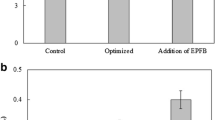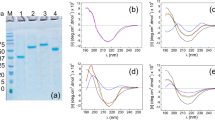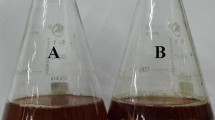Abstract
By-products resulting from lignocellulosics pretreatment affect the digestibility of resulting whole slurries, but this can be minimized by additives supplementation. In this work, a family 3 carbohydrate-binding module (CBM3), recombinantly produced from Escherichia coli, was used as additive in the enzymatic hydrolysis of the whole slurry from autohydrolyzed Eucalyptus globulus wood (EGW). At the higher dosage used (30 mg/gsolids), CBM3 led to an increase in glucose yield from 75 to 89%. A similar result was obtained for bovine serum albumin (BSA) (11% increase), which has a well-documented additive effect. CBM3 had no effect on the non-productive binding of enzymes, since it could not bind to EGW lignin, while it rapidly bound to cellulose, as shown by fluorescence microscopy. CBM3 is a valid additive for enhanced lignocellulosic saccharification and a valuable alternative to costly additives (e.g. polyethylene glycol) as it can be affordably produced from heterologous bacterium, thus contributing to more cost-efficient biomass valorization bioprocesses.




Similar content being viewed by others
References
Andrade FK, Costa R, Domingues L, Soares R, Gama M (2010) Improving bacterial cellulose for blood vessel replacement: functionalization with a chimeric protein containing a cellulose-binding module and an adhesion peptide. Acta Biomater 6:4034–4041
Arantes V, Saddler JN (2010) Access to cellulose limits the efficiency of enzymatic hydrolysis: the role of amorphogenesis. Biotechnol Biofuels 3:4
Arevalo-Gallegos A, Ahmad Z, Asgher M, Parra-Saldivar R, Iqbal HM (2017) Lignocellulose: a sustainable material to produce value-added products with a zero waste approach-A review. Int J Biol Macromol 99:308–318
Bayer EA, Kenig R, Lamed R (1983) Adherence of Clostridium thermocellum to cellulose. J Bacteriol 156:818–827
Bayer EA, Lamed R, White BA, Flint HJ (2008) From cellulosomes to cellulosomics. Chem Rec 8:364–377
Capolupo L, Faraco V (2016) Green methods of lignocellulose pretreatment for biorefinery development. Appl Microbiol Biotechnol 100:9451–9467
Demain AL, Vaishnav P (2009) Production of recombinant proteins by microbes and higher organisms. Biotechnol Adv 27:297–306
Gao SH, You C, Renneckar S, Bao J, Zhang YHP (2014) New insights into enzymatic hydrolysis of heterogeneous cellulose by using carbohydrate-binding module 3 containing GFP and carbohydrate-binding module 17 containing CFP. Biotechnol Biofuels 7:24
Gomes D, Rodrigues AC, Domingues L, Gama M (2015) Cellulase recycling in biorefineries—Is it possible? Appl Microbiol Biotechnol 99:4131–4143
Hall M, Bansal P, Lee JH, Realff MJ, Bommarius AS (2011) Biological pretreatment of cellulose: enhancing enzymatic hydrolysis rate using cellulose-binding domains from cellulases. Bioresour Technol 102:2910–2915
Kim IJ, Lee HJ, Choi IG, Kim KH (2014) Synergistic proteins for the enhanced enzymatic hydrolysis of cellulose by cellulase. Appl Microbiol Biotechnol 98:8469–8480
Ko JK, Um Y, Park Y-C, Seo J-H, Kim K-H (2015) Compounds inhibiting the bioconversion of hydrothermally pretreated lignocelllulose. Appl Microbiol Biotechnol 99:4201–4212
Lamed R, Naimark J, Morgenstern E, Bayer EA (1987) Specialized cell surface structures in cellulolytic bacteria. J Bacteriol 169:3792–3800
Liu H, Sun JL, Leu SY, Chen SC (2016) Toward a fundamental understanding of cellulase-lignin interactions in the whole slurry enzymatic saccharification process. Biofuels Bioprod Biorefining 10:648–663
Machado J, Araújo A, Pinto R, Gama FM (2009) Studies on the interaction of the carbohydrate binding module 3 from the Clostridium thermocellum CipA scaffolding protein with cellulose and paper fibres. Cellulose 16:817–824
Mello BL, Polikarpov I (2014) Family 1 carbohydrate binding-modules enhance saccharification rates. AMB Express 4:36
Mhlongo SI, den Haan R, Viljoen-Bloom M, van Zyl WH (2015) Lignocellulosic hydrolysate inhibitors selectively inhibit/deactivate cellulose performance. Enzyme Microb Technol 81:16–22
Oliveira C, Carvalho V, Domingues L, Gama FM (2015a) Recombinant CBM-fusion technology—applications overview. Biotechnol Adv 33:358–369
Oliveira C, Sepúlveda G, Aguiar TQ, Gama FM, Domingues L (2015b) Modification of paper properties using carbohydrate-binding module 3 from the Clostridium thermocellum CipA scaffolding protein produced in Pichia pastoris: elucidation of the glycosylation effect. Cellulose 22:2755–2765
Pinto R, Moreira S, Mota M, Gama M (2004) Studies on the cellulose-binding domains adsorption to cellulose. Langmuir 20:1409–1413
Rahikainen JL, Moilanen U, Nurmi-Rantala S, Lappas A, Koivula A, Viikari L, Kruus K (2013) Effect of temperature on lignin-derived inhibition studied with three structurally different cellobiohydrolases. Bioresour Technol 146:118–125
Ramos R, Moreira S, Rodrigues A, Gama M, Domingues L (2013) Recombinant expression and purification of the antimicrobial peptide magainin-2. Biotechnol Prog 29:17–22
Rodrigues AC, Haven MO, Lindedam J, Felby C, Gama M (2015) Celluclast and Cellic(R) CTec2: saccharification/fermentation of wheat straw, solid-liquid partition and potential of enzyme recycling by alkaline washing. Enzyme Microb Technol 79–80:70–77
Romaní A, Garrote G, Alonso JL, Parajó JC (2010) Bioethanol production from hydrothermally pretreated Eucalyptus globulus wood. Bioresour Technol 101:8706–8712
Romaní A, Ruiz HA, Pereira FB, Domingues L, Teixeira JA (2014) Effect of hemicellulose liquid phase on the enzymatic hydrolysis of autohydrolyzed Eucalyptus globulus wood. Biomass Conv Bioref 4:77–86
Tormo J, Lamed R, Chirino AJ, Morag E, Bayer EA, Shoham Y et al (1996) Crystal structure of a bacterial family-III cellulose-binding domain: a general mechanism for attachment to cellulose. EMBO J 15:5739–5751
Várnai A, Makela MR, Djajadi DT, Rahikainen J, Hatakka A, Viikari L (2014) Carbohydrate-binding modules of fungal cellulases: occurrence in nature, function, and relevance in industrial biomass conversion. Adv Appl Microbiol 88:103–165
Voutilainen SP, Nurmi-Rantala S, Penttilä M, Koivula A (2014) Engineering chimeric thermostable GH7 cellobiohydrolases in Saccharomyces cerevisiae. Appl Microbiol Biotechnol 98:2991–3001
Wan W, Wang D, Gao X, Hong J (2011) Expression of family 3 cellulose-binding module (CBM3) as an affinity tag for recombinant proteins in yeast. Appl Microbiol Biotechnol 91:789–798
Wang H, Kobayashi S, Mochidzuki K (2015) Effect of non-enzymatic proteins on enzymatic hydrolysis and simultaneous saccharification and fermentation of different lignocellulosic materials. Bioresour Technol 190:373–380
Yan L, Zhang L, Yang B (2014) Enhancement of total sugar and lignin yields through dissolution of poplar wood by hot water and dilute acid flowthrough pretreatment. Biotechnol Biofuels 7:76
Yang B, Wyman CE (2006) BSA treatment to enhance enzymatic hydrolysis of cellulose in lignin containing substrates. Biotechnol Bioeng 94:611–617
Zhai R, Hu J, Saddler JN (2015) What are the major components in steam pretreated lignocellulosic biomass that inhibit the efficcacy of cellulase enzyme mixtures? ACS Sustain Chem Eng 4:3429–3436
Acknowledgments
This work was developed under the strategic funding of UID/BIO/04469/2013 unit, COMPETE 2020 (POCI-01-0145-FEDER-006684) and BioTecNorte operation (NORTE-01-0145-FEDER-000004) funded by the European Regional Development Fund under the scope of Norte2020—Programa Operacional Regional do Norte. The research leading to the reported results has received funding from Fundação para a Ciência e a Tecnologia (FCT) through the project MultiBiorefinery (POCI-01–0145-FEDER-016403) and through grants to C. Oliveira (SFRH/BPD/110640/2015) and D. Gomes (SFRH/BD/88623/2012).
Author information
Authors and Affiliations
Corresponding author
Ethics declarations
Conflict of interest
The authors declare that they have no conflict of interest.
Rights and permissions
About this article
Cite this article
Oliveira, C., Romaní, A., Gomes, D. et al. Recombinant family 3 carbohydrate-binding module as a new additive for enhanced enzymatic saccharification of whole slurry from autohydrolyzed Eucalyptus globulus wood. Cellulose 25, 2505–2514 (2018). https://doi.org/10.1007/s10570-018-1722-6
Received:
Accepted:
Published:
Issue Date:
DOI: https://doi.org/10.1007/s10570-018-1722-6




